Sir Christopher Baynham (c.1472-1540)
Born: c.1472 at Clearwell, Gloucestershire
Parents: Thomas Baynham of Clearwell and Alice Walwyn
Married: 1502 to Jane Morgan
Died: 1540 at Clearwell
Christopher, my ten times great-grandfather, was born c.1472 at Clearwell Court, near Newland in Gloucestershire.
Christopher married Jane Morgan, daughter of Thomas Morgan and Jane Herbert, at Pen Coed, Llanfarthin, Monmouthshire in 1502, when he was around 30 and she was also 24. They had six children: George, Thomas (my nine times great-grandfather), Alice, Joan (Jane?), Dorothy and Mary. Jane Morgan died in 1544.
Christopher died on 22nd June 1540 at Clearwell, aged about 68.
Unlike for his two elder half-brothers Alexander and William, there is no unequivocal evidence of Christopher having been a member of an Inn of Court or Chancery when he was aged around 21. It is possible that he was the ‘Christopher Bayne’ who was a member of Clements Inn, but probably not.
The first mention of him is in 1493 when Christopher Beynam, armiger (so presumably he was now at least 21), appears alongside his elder half-brother Sir Alexander Beynam, knight (aged 34) as Recoverer, his other half-brother William (aged 30) and others in an action in the Court of Common Pleas.


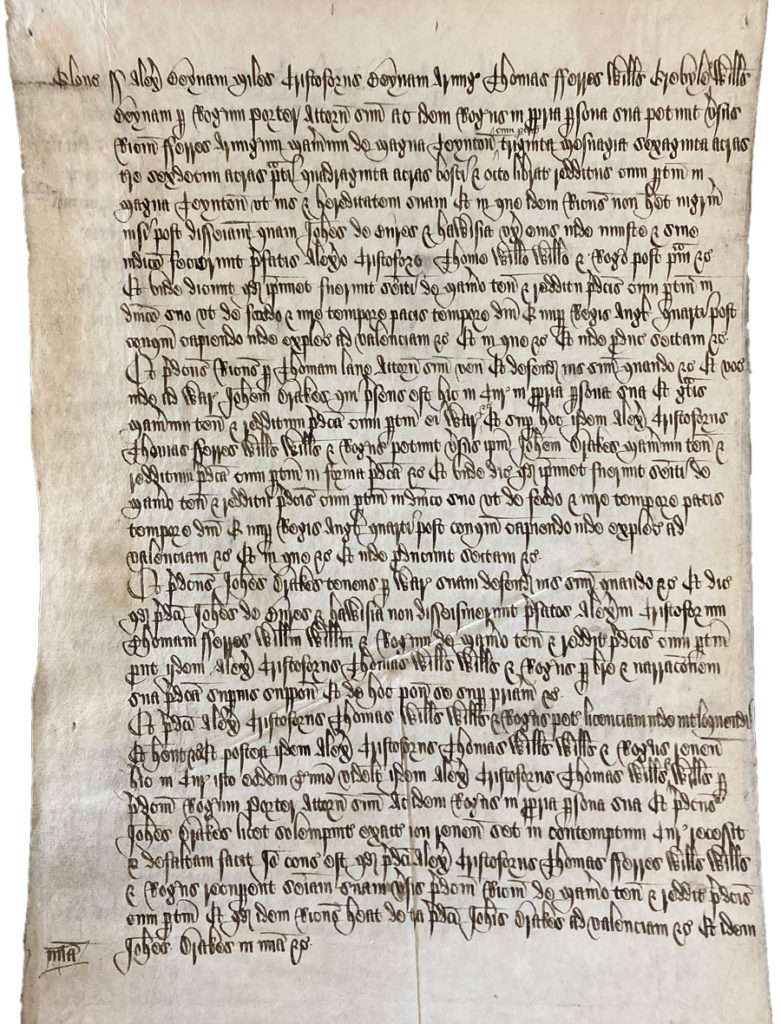
On 7th April 1494 the three brothers Alexander, Christopher and William (along with their father Thomas and others) were recorded as feoffees of the manor of Puplyngton and other lands in the IPM of Robert Russell Senior. Robert had previously agreed with Thomas that his son and heir Robert Russell the Younger would marry Thomas’ daughter Elizabeth and in consideration of a sum of money paid to Robert Senior by Thomas he enfeoffed the Baynhams and others to the use of Robert the Younger and Elizabeth, who by then was his wife.

On 28th October 1496, the three brother Alexander, Christopher and William (along with William Grevyle, Roger Porter and Thomas Ferrers) were again recorded as feoffees – this time of the manor of Great Teynton in Gloucestershire in the IPM of Richard Ferrers.
By late 1498, Christopher was already a Squire for the Body to Henry VII, as evidenced by the repeat grant on 24th November to Thomas of the lordship, town and castle of St. Briavels for 30 years from Michaelmas 1497, rendering the yearly amount of 80l. plus an increment of 3l. 6s. 8d., at the feast of All Saints – this time jointly with “Christopher Baynam (his son), esquire for the body” .

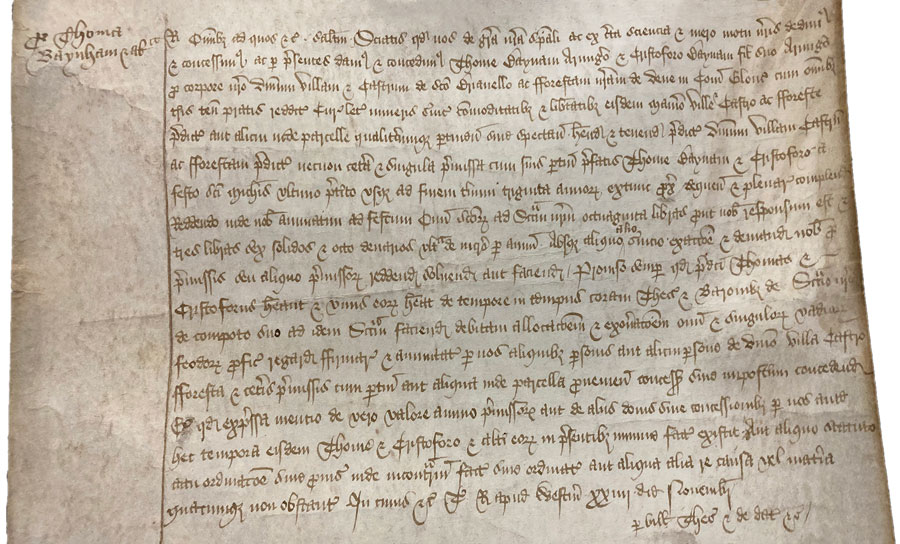
Christopher appears to have sat on fewer royal commissions than his father Thomas or elder half-brothers Alexander and William, but he was a Commissioner of the Peace for Gloucestershire for almost four decades, from 1501 to 1540.
Aged 29, he was joined on his first commission in 1501 by his elder half-brother Sir Alexander who by that time already had experience of several commissions.
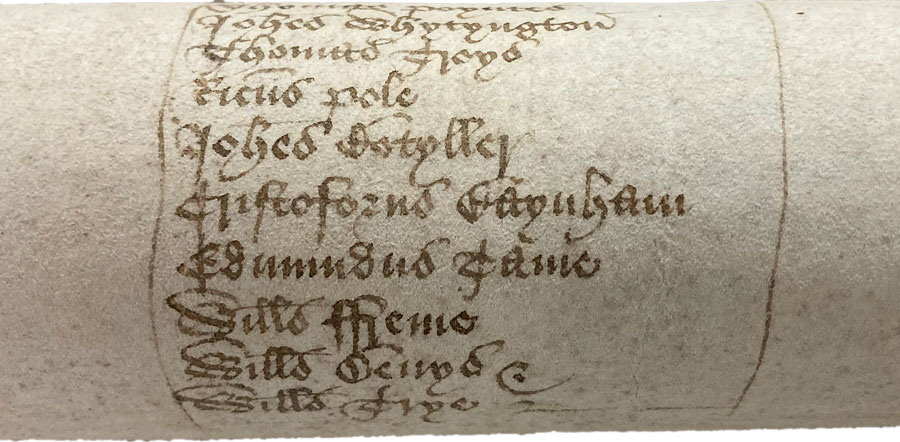
In 1502, aged around 30, he married Jane Morgan, daughter of Thomas Morgan and Jane Herbert, at Pen Coed, Llanfarthin, Monmouthshire in 1502. Jane’s family — [ link to her pedigree, back to Rhodri the Great ].
Together they had six children – their eldest child, George, son and heir to the Clearwell Estate, produced thirteen children, including a future Lady-in-Waiting to Queen Mary I and several knights and Sheriffs.
Next came my nine times great-grandfather Thomas, who later became known as ‘Thomas Baynham of Noxon Park’.
And then four daughters –
1. Alice who married John Walshe (d.1541), son of John Walsh of Shelsley Walsh, Worcestershire and had six children. Their son Francis, who on his father’s death was a minor and became the ward of Alice’s brother Sir George Baynham, and his wife Ann are buried in the church of St. Andrew in Shelsey Walsh; their painted wooden tomb bears the Baynham arms and an inscription which includes “Allice the daughter of Christopher Baynham knight”.


2. Joan / Jane (living in 1518) who married James, son of Thomas Hyett of Lydney and had five children;
3. Dorothy who married Walter Probert, the son of Walter ap Robert and Joyce Herbert;
4. Mary who married Thomas Mylle / Mill of Harescombe, Gloucestershire but had no children.
[ also Margaret, who married John de Ken of Kenn ? ]
In 1509 he attended the funeral of King Henry VII on 11th May, as a Squire for the Body (his elder half-brother Sir Alexander was also there, as a Knight in Attendance).

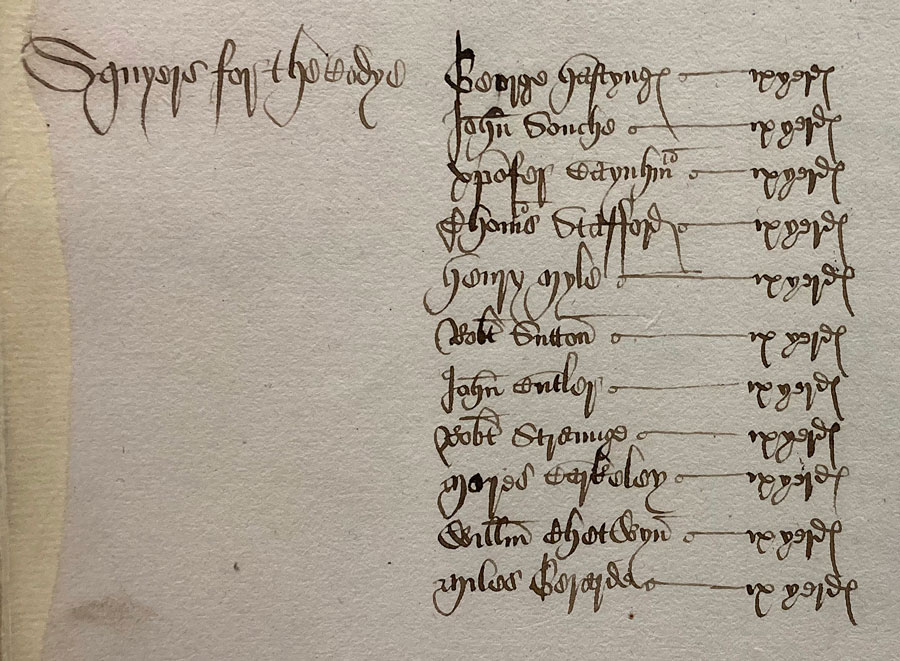
In 1511, aged about 39, Christopher was appointed Sheriff of Gloucestershire for the first time – on 8th November, recorded as ‘Christopher Beynham esq’. Sir Alexander Baynham, his eldest half-brother, gave a recognizance of 40l. for his conduct as sheriff.

From his term of office there is an inquisition made before him at Dursley in Gloucestershire in the Chancery case against Edmund Wicks of Dursley, esquire, and Nicholas Wicks his son and heir;
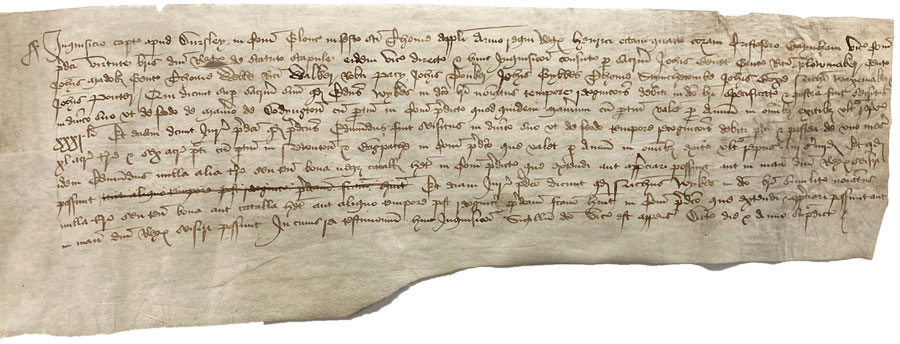

and there is an endorsement to the inquisition: Christopher’s response that Edmund and Nicholas Wicks were not found in his bailiwick.

Around this time Christopher also appears as a defendant in two court cases – one in the Court of Chancery, Six Clerks Office brought against Christopher and Sir Alexander Baynham by John, son of Walter Loksmyth regarding the retention of deeds relating to messuages and land in Mitcheldean and Abinghall, Gloucestershire;
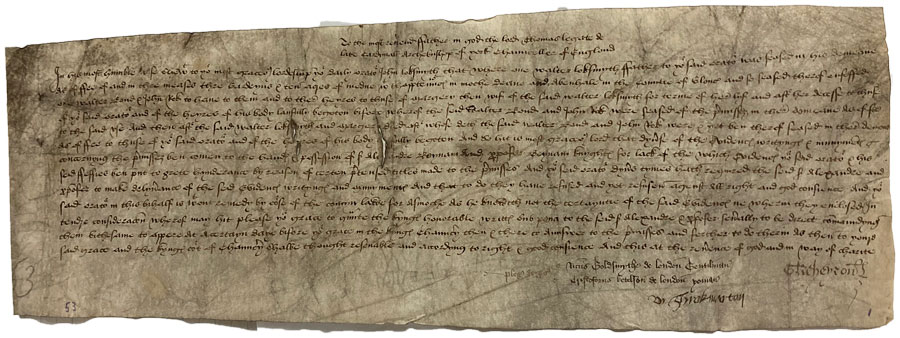
the other in the Court of Requests brought by a Philip Cachemay regarding the office of riding forester in the Forest of Dean and office of ale taster at Newland, Gloucestershire;
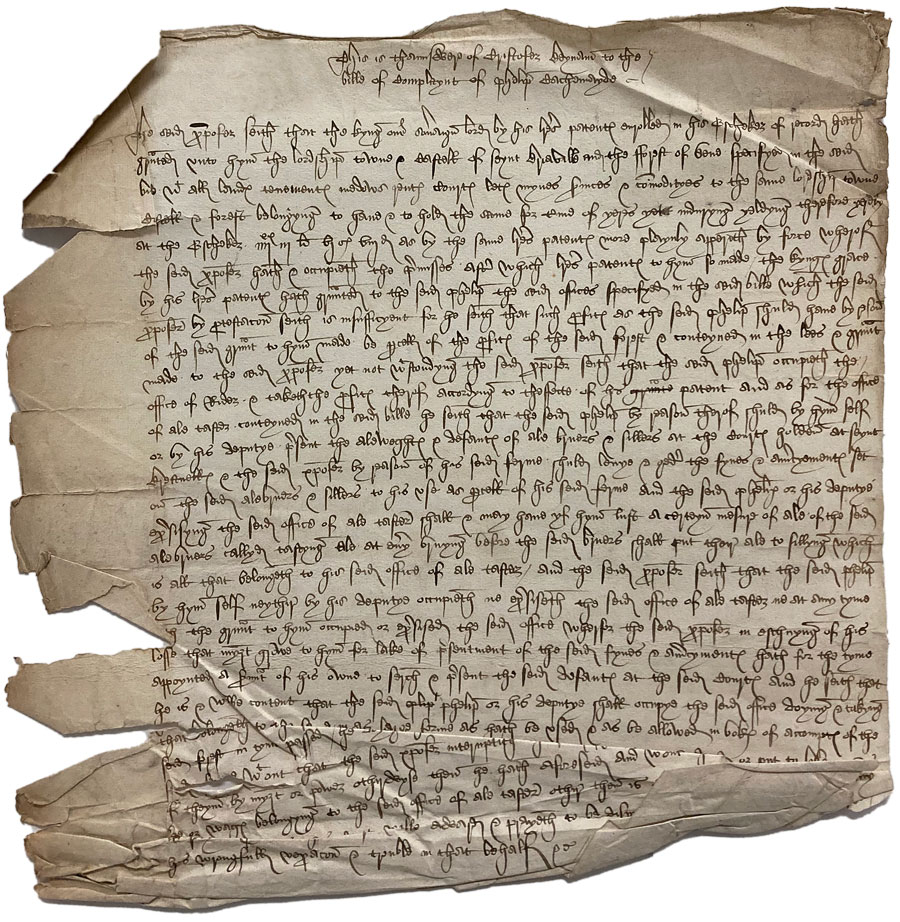
By 1512 King Henry VIII was preparing for war against France and began a recruitment campaign, drawing on two categories of men: noblemen and gentleman who served in person with their men and those who remained at home and provided troops. Christopher was in the former category and was included in a list headed “these persons whose names follow have the King’s letters sent to them to make and send the numbers following, and to certify by a day to serve the King’s grace by land” – he received a summons to attend with twenty men, as did his eldest half-brother Sir Alexander.
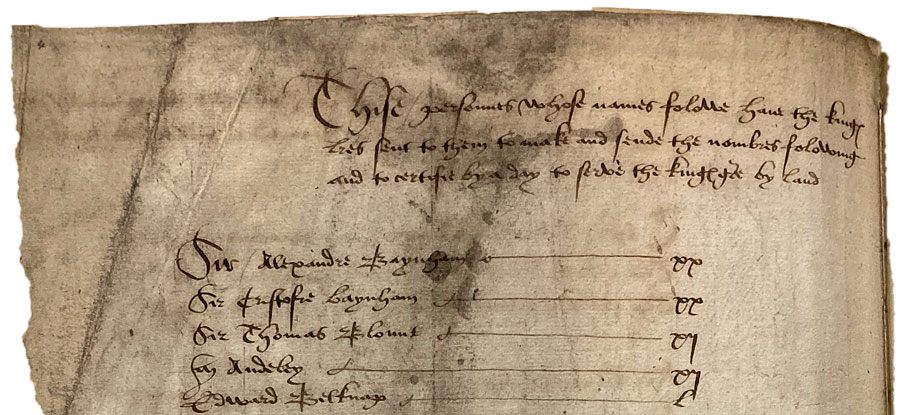
In 1513 Christopher (then aged around 41) went to France with King Henry VIII’s army to fight against Louis XII of France.

Prior to departure, he was granted ‘Protection; going to the war’ by the King on 10th May.

As a Squire for the Body to the King he would have been a member of the middle-ward which travelled with the King and did not arrive in Calais until 30th June, by which time the siege of Therouanne (in which his elder half-brother Sir Alexander Baynham was actively involved, as captain of the pioneers of the rear-ward) was well under way.
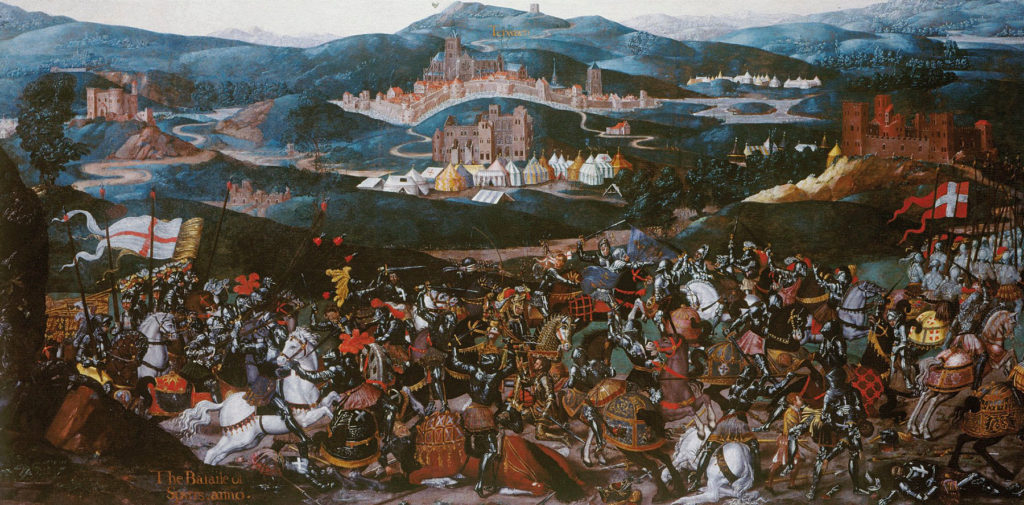
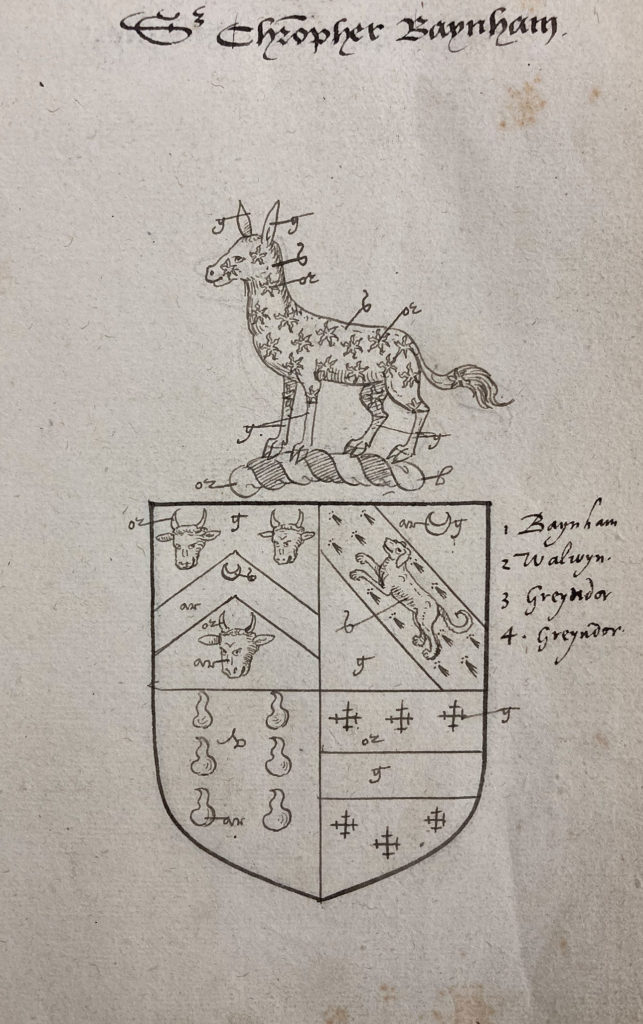
The middle-ward only joined the siege on 1st August, but now the army was finally able to completely surround the town and prevent the French cavalry from revictualling the garrison; on 16th August the final attempt by the French heavy cavalry resulted in defeat by the English cavalry in the Battle of Guinegate or Battle of the Spurs, so named for the speed with which the French fled.
It is probable that Christopher took part in this victory, as he was one of the 49 men later knighted by Henry for distinguished service in the 1513 campaign.
After the fall of Therouanne, Henry also took Tournai.
On 2nd October 1513 Christopher was knighted there by the king; Henry conferred the honour after he had attended mass at the cathedral.
Christopher’s arms were quartered: Baynham, Walwyn, Greyndour and Greyndour – reflecting ealier marriages.
In 1514 Christopher was granted a pardon and release as Sheriff of Gloucestershire. In the same document, his half-brother Sir Alexander Baynham of Westbury was released of his recognizance of 40l., which he had given on 10th November 1511, shortly after Christopher had taken up the office of sheriff for the first time. Others were also released of their recognizances – Stephen Cotton of Tewkesbury, William Huntley of London and Mary, widow and executrix of Christopher Throkmerton of Trilley.
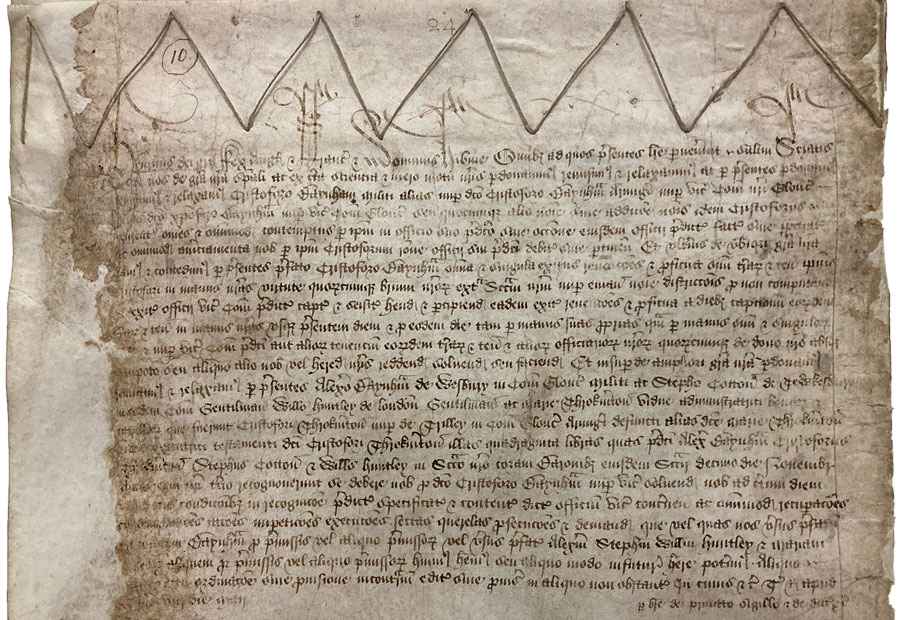
 In 1516 (aged about 44) Christopher was elevated within the royal household – he appears as a Knight for the Body in ‘A book of the names of all the king’s officers and servants sworn to attend in his grace’s most honourable chamber’.
In 1516 (aged about 44) Christopher was elevated within the royal household – he appears as a Knight for the Body in ‘A book of the names of all the king’s officers and servants sworn to attend in his grace’s most honourable chamber’.

In 1517 Christopher was again appointed Sheriff of Gloucestershire – on 5th November, recorded as ‘Christopher Baynham knt’.

Other members of his close family had also held the office of Sheriff – his father Thomas in 1471 and 1477; his older half-brother Alexander in 1482, 1498, 1502-4 and 1516. His son George would follow in 1544, as would two of his grandsons, Richard in 1570 and Thomas in 1582 and 1602.
Sir Christopher inherited the manors of Clearwell, Noxon and Hatherways Court from his mother Alice when she died in late 1518. Her IPM recorded that he was her son and heir.
In 1520, in a memorial of things necessary for the transporting of the King for the interview between him, the French king, their queens, queen Mary dowager of France, and the mother of the French king, there are lists of noblemen and others requested to attend. Sir Christopher was chosen to represent Gloucestershire, along with The Duke of Buckingham, Sir Maurice Barkeley, William Denys, Sir William Kyngston, Sir John Hungerford, Sir Edward Wadham and Sir John Brydges (Christopher’s nephew) at what would become known as the Field of the Cloth of Gold, held between 7th and 24th June.

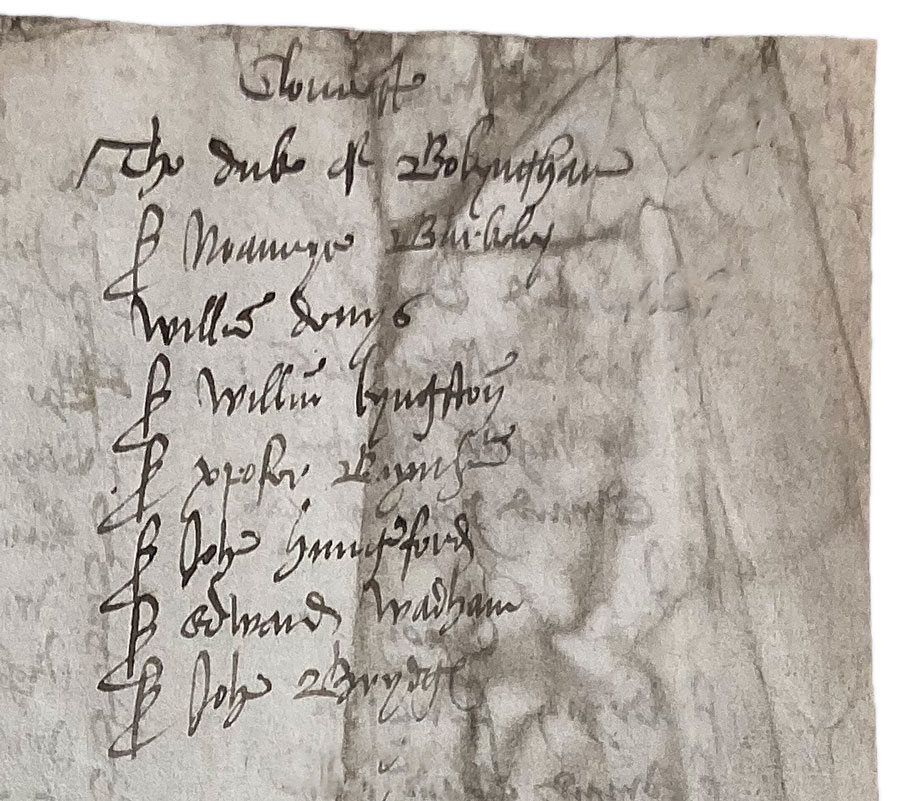

On 8th May 1521, an indictment in London at the Guildhall before the Lord Mayor and a Special Commission of Oyer and Terminer found that Edward Duke of Buckingham, late of Thornbury, Gloucestershire had committed treason.

A similar indictment found at Bristol Castle where the jury was comprised of twenty Gloucestershire men, including Sir Alexander Baynham and Sir Christopher Baynham.
On 16th May 1521, the Register of Bishop Booth records that Sir Christopher Baynam presented John Bolter to the Greyndour chantry in the church of All Saints in Newland and as headmaster of the chantry school.
In 1522 the King ordered a military survey of England, by county (the survey of Gloucestershire is one of the few to have survived). It was intended to record personal wealth in land and goods, items of military equipment such as suits of armour and weapons) and whether a man was fit for combat.
Sir Christopher appears with a land value several times and as steward once : for Newland and Coleford “The king is lord of the vill[age] of Newland and is worth £10, Sir William Kyngston steward, Sir Christopher Baynham lord of Coleford and is worth £20”, the rectory and vicarage of Newland and the vicar and clerk of the chantry plus a further 79 men of varying worth who possess their own combinations of harness and almain rivets (types of armour), hauberks (shirts of chain mail), bows & arrows, swords & shields, daggers, lances, bills and other weapons, plus a few horses; for Ruardean, there are Sir Christopher (£14) and his half-brother Sir Alexander (£6), a chaplain and 62 others; for Lower Ley, “the prior of Llanthony (£5 13s 9d), George Earl of Shrewsbury (£21), Simon Milborne (£15), Sir Christopher Baynam (£3 12s 5d)” plus 26 others; also for Kempley (£23 4d) plus ——-, Longhope (steward) plus ——- and Nass (£10) plus ——-.
For Clearwell, as well as a land value (£30), he also has a goods value (£333 6s 8d) as this is where he lives; a further 57 men and their equipment are listed, but unlike his half-brother Sir Alexander, Sir Christopher is not recorded as being in possession of any armour or weapons himself.
In a letter dated 7th July 1522, Richard Sampson informed Cardinal Wolsey that the King “gave charge to Sir Wm. Kingston to levy 300 pioneers in the forest of Dean, and letters will be made with all diligence that they may be at Dover on the 31st inst.

Sir Christopher Beynham will command 200, and Kingston the rest. Sir Henry Marney is also ordered to provide 200 miners”.
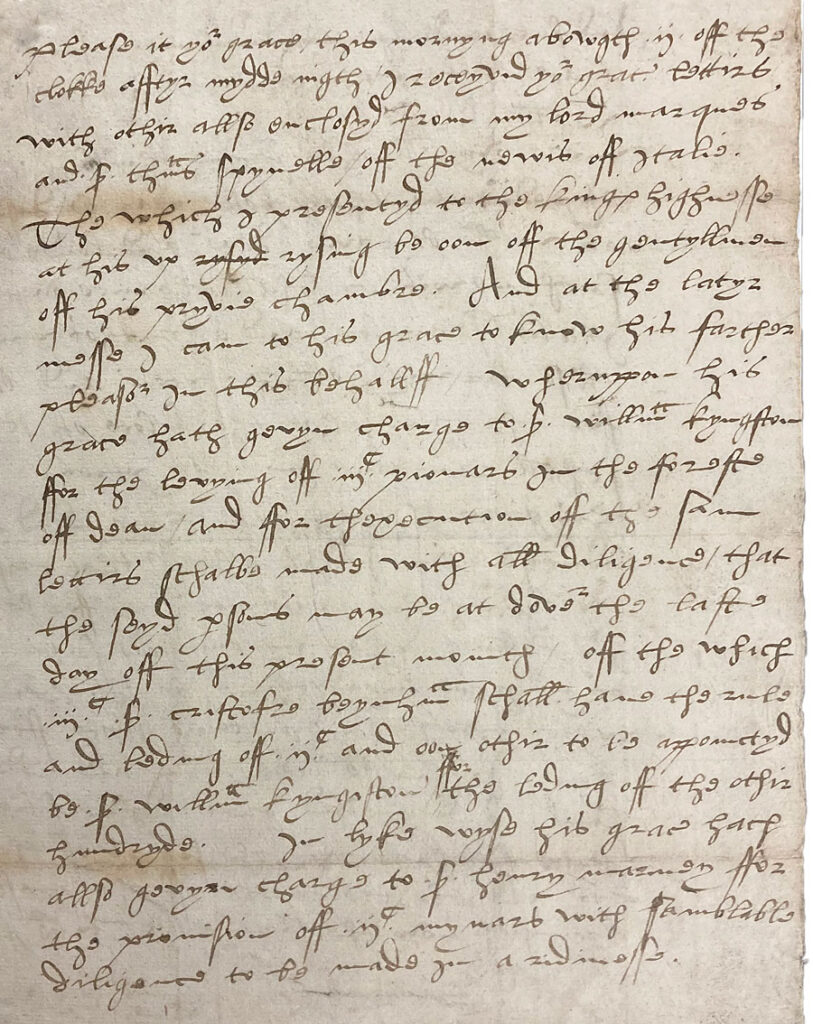
In a letter dated 25th April 1528, Sir William Sandys informed Cardinal Wolsey that he had noted that “100 horse and 200 foot would be sufficient to accompany him to Guisnes” and, having received letters from the King, has now “sent forth 41 to the best places for procuring the 200 footmen, as he will see by the enclosed list”.

Among the recipients of the letters (most of which appear to be in the South West) are Sir Christopher Baynham, Sir William Denys, William Tracy and the town of Gloucester.
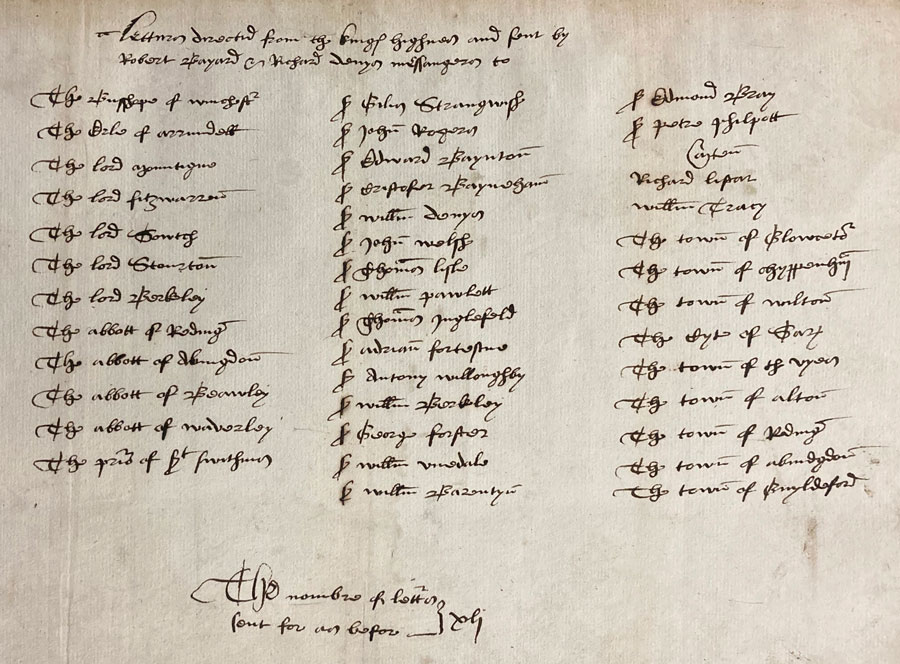
The Register of Bishop Booth records that Sir Christopher Baynham presented to the Greyndour chantry again on 12th January 1530, on the resignation of John Bolter. The appointee was a David Smith who died after only a year, so another presentation – of Roger Wynter, as chantry priest and chantry school headmaster – was recorded on 17th November 1731, by Sir Christopher Beynam.
The following year, Christopher’s nephew James was burned at the stake for his religous beliefs at Smithfield, London on 30th April 1532.
In a letter from 1532 sent by Sir William Paulet to Thomas Cromwell he writes ” … And I pray you send me the book of the forest of Deane, that you and I may speak with Sir Christopher Bayneham thereupon before he leaves London”.

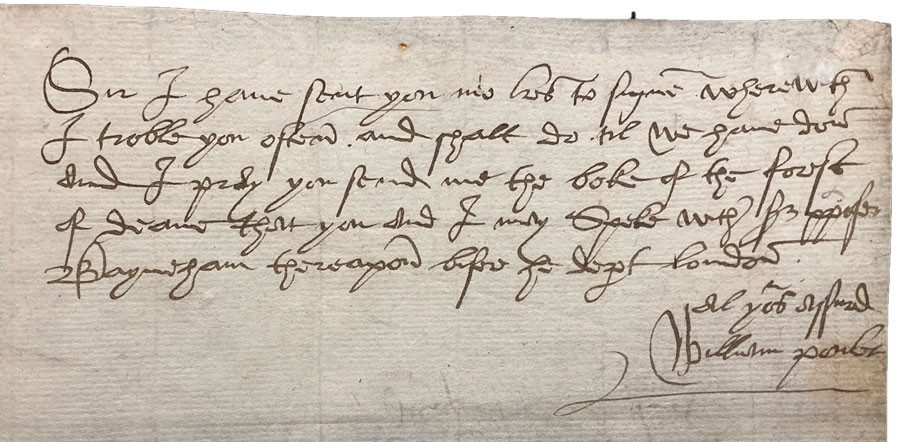
At the time of the Northern rebellion or Pilgrimage of Grace in 1536, Sir Christopher and his son George are mentioned in the king’s plans to put down the uprising; they were included in lists of gentlemen in the southern and midland counties to whom it was proposed to write letters – overnight watches were to be kept in every shire, beacons were to be prepared in every port and watches kept there too and posts were to be set up by special commandment. George was also required to provide 150 men for the Goucesterhsire contingent.


In 1538 Christopher and his son George appeared as defendants in two cases in the Court of Star Chamber (the Supreme Court of the day):
the first was brought by John ap Gwellym, Sewer of the King’s Chamber, regarding an assault in the house of John Wynter at Lydney, Gloucestershire
and the second (related?) case brought by John Wynter himself regarding forcible entry there.


On 4th July 1538 Christopher was appointed to a Commission of Oyer and Terminer for several counties in the Midlands and the South West, including Gloucestershire.

He was appointed again in the following year.

In the Spring of 1539 musters of able men were taken by county.
For Gloucestershire, the Certifcate was given by Sir Christopher Baynham, his son George and three others “of the muster of armour, weapons and able men, by virtue of the King’s commission to them and othes, taken for the hundreds of Botlowe, Weysbury, Briavelles, Bledislow, and the duchy of Lancaster, in co. Glouce., according to the division among all the commissioners made 31st March 1539.”

For each place (starting with Dymmock), the roll lists men with horse and harness, their various weapons and in the margin a letter ‘a’ denoting those who were ‘able’.
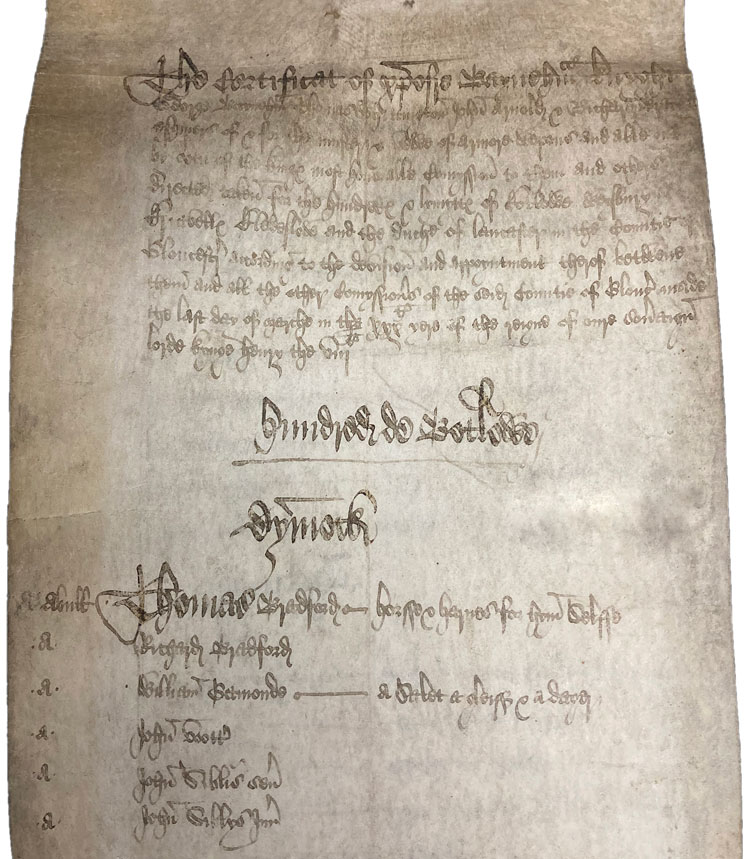
Sir Christopher’s final appointment was on 4th February 1540 – as a Commissioner of the Peace on the Oxford Circuit.
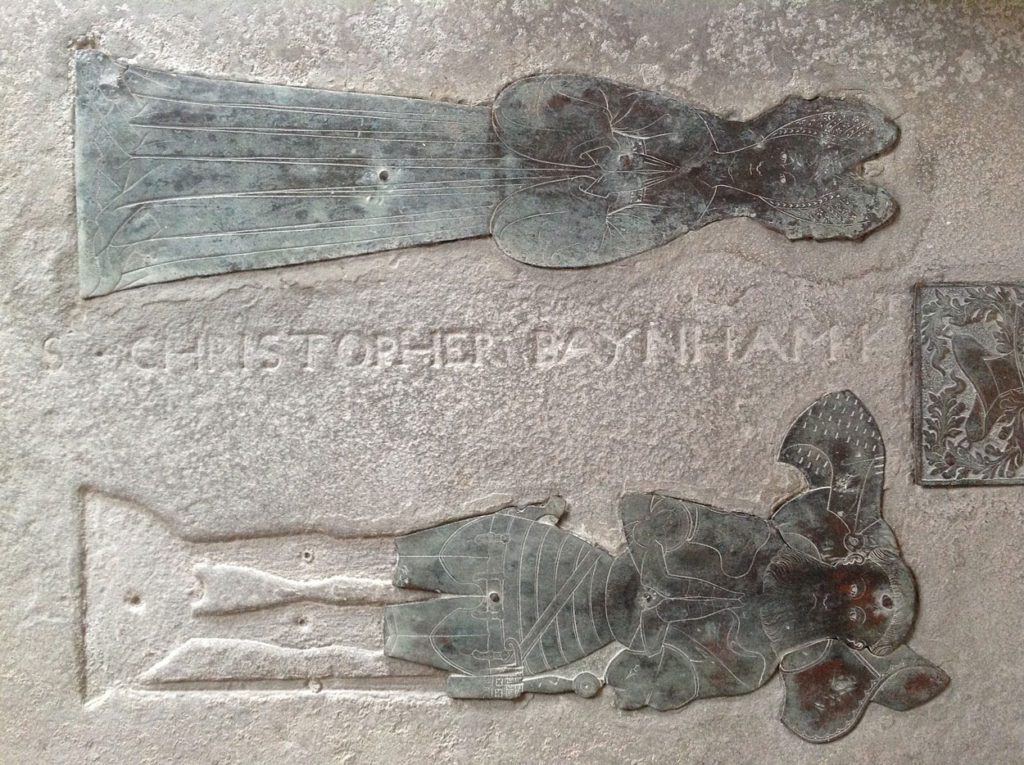
He died on 22nd June 1540 and was buried in All Saints Church, ‘The Cathedral of The Forest’, in Newland.
Judging by the lettering “Sir Christopher Baynham Kt” incised into the top of the tomb of Robert Greyndour (d.1443) and his wife Joan (Johanna Rugge d.1485), it appears that Christopher’s body was placed into their tomb.
Robert had been the first person to use the suffix ‘of Clearwell’ and probably built the earliest manor house there; that property was among the estates inherited by Christopher from his mother Alice Walwyn.
Christopher was survived by his wife Jane who died three years later.
There is no evidence of Christopher having left a will or of an Inquisition Post Mortem being held after his death.

In May 1541 his eldest son George received livery of those lands and possessions to which he was entitled.

Notes:
Most genealogical sources show Christopher’s birth year as c.1478. However, he is recorded in 1493 as ‘armiger’, so must have been at least 21 by then, and in the following year he is a feoffee of land, so would definitely have to to be 21. This means he would have been born around 1472.
This would not fit well with the second marriage of his father Thomas Baynham of Clearwell to Christopher’s mother Alice Walwyn being in 1470, as Christopher was their fourth child … so Thomas must have married Alice somewhat earlier, perhaps in around 1468? (see note at foot of page for Thomas Baynham of Clearwell)
In 1538 …
Acknowledgements:
- 1493 Action in Court of Common Pleas in name of Christopher Baynham and others – National Archives, CP 40/296/269
- 1494 IPM of Robert Russell Snr. records enfeoffment of Christopher Baynham and others – National Archives, C 142/9/17
- 1498 Grant to Christopher Baynham, as esquire for the body, of joint Lordship of St. Briavels – National Archives, C 60/309, m. 13
- 1501 Appointment of Christopher Baynham to Commission of the Peace – National Archives, C 66/587, m. 7 (20)d
- 1509 Christopher Baynham as Equire for the Body in attendance at funeral of Henry VII – National Archives, LC 2/1, f. 135
- 1511 Appointment of Christopher Baynham as Sheriff of Gloucestershire – C 82/370
- 1511 Inquisition before Christopher Baynham as Sheriff, against Wicks with response – National Archives, C 131/99/11
- 1511 Case against Christopher Baynham as Sheriff by Richard Cachemay – National Archives, REQ 2/4/306
- 1512 Call to Arms for War against France issued to Christopher Baynham – National Archives, SP 1/2, f. 111
- 1513 Christopher Baynham granted protection for going to the war – National Archives, C 76/194, m. 13
- 1513 Arms of Christopher Baynham, knighted by King Henry VIII – British Library, R. MS 7 xiv. f. 100
- 1514 Pardon & Release of Christopher Baynham for his role as sheriff – National Archives, C 66/622, m. 10
- 1515 Christopher Baynham as co-defendant in case of Locksmyth v Beynam – National Archives, C 1/425/53
- 1516 Christopher Baynham elevated to Knight for the Body of Henry VIII – National Archives, PRO 31/8/144, m. 245
- 1517 Appointment of Christopher Baynham as Sheriff of Gloucestershire – National Archives, C 82/454
- 1520 Christopher Baynham to represent Gloucestershire at the Field of Cloth of Gold – British Library, Cotton MS Titus, B. i. f. 123
- 1521 Christopher Baynham as juror at indictment of Duke of Buckingham at Bristol castle – National Archives, K8/5, m. 13
- 1522 Letter referring to Christopher Baynham sent by Richard Sampson to Cardinal Wolsey – National Archives, SP 1/25, ff. 25-6
- 1528 Letter referring to Christopher Baynham sent by Sir William Sandys to Cardinal Wolsey – National Archives, SP 1/47, ff. 234-7
- 1532 Letter referring to Christopher Baynham sent by Sir William Paulet to Thomas Cromwell – National Archives, SP 1/73, f. 132
- 1536 Christopher Baynham in Gloucestershire contingent against Northern Uprising – National Archives, SP 1/107, ff. 39-56
- 1538 Christopher Baynham as co-defendant in case of Ap Gwellym v Beynam – National Archives, STAC 2/16/373 + 379-381
- 1538 Christopher Baynham as co-defendant in case of Wynter v Beynam – National Archives, STAC 2/23/218
- 1538 Appointment of Christopher Baynham to Commission of Oyer and Terminer – National Archives, C 66/678, m. 14
- 1539 Certificate given by Christopher Baynham on Muster Roll – National Archives, E 101/59/10
- 1541 Livery of lands and possessions of Christopher Baynham to son George – National Archives, C 66/701, m. 21
- c.1499 Possible membership of Clements Inn – ‘The Men of Court 1440 to 1550: A prosopography of the Inns of Court and Chancery and the Courts of Law’ by Sir John Baker (p.285)
- 1513 Sir Christopher Baynham’s knighthood & arms – ‘The names and Armes of such as haue ben aduaunced to the honorable Ordre of knighthoode, Henry IV – James I, mostly in the hand of Rober Glover’ (Henry VIII Cotton MSS, Claudius C.iii. Fol 68-144), seen at the British Library
- 1522 Military Survey of Gloucestershire –
- Tomb of Francis Walshe – Mark Baynham
- Battle of the Spurs – Wikimedia Commons (public domain image, from 16C Flemish School painting in the Royal Collection)
- The Field of the Cloth of Gold – Wikimedia Commons (public domain image, from 16C British School painting in the Royal Collection)
- Tomb of Robert and Joan Greyndour – Mark Baynham
